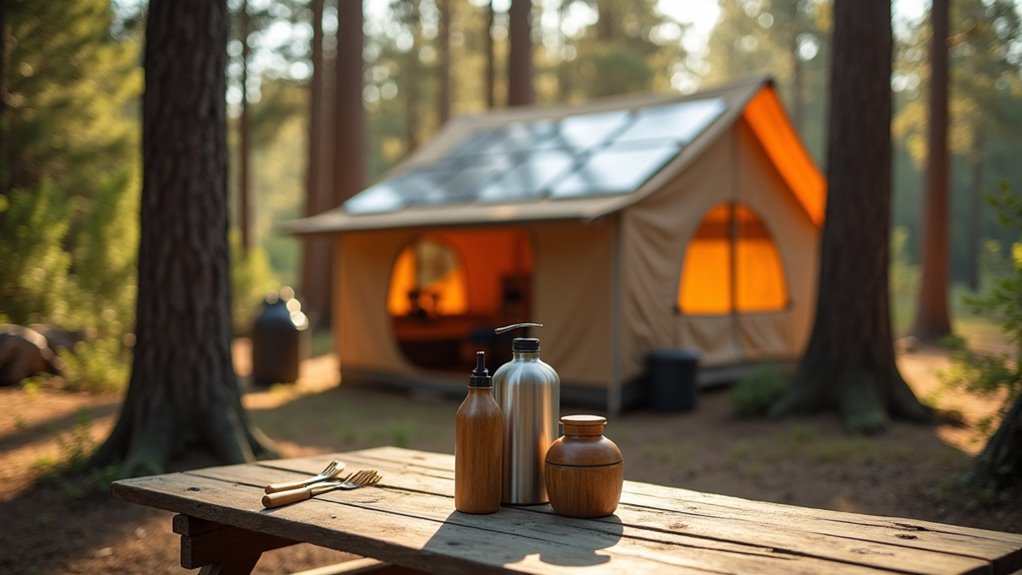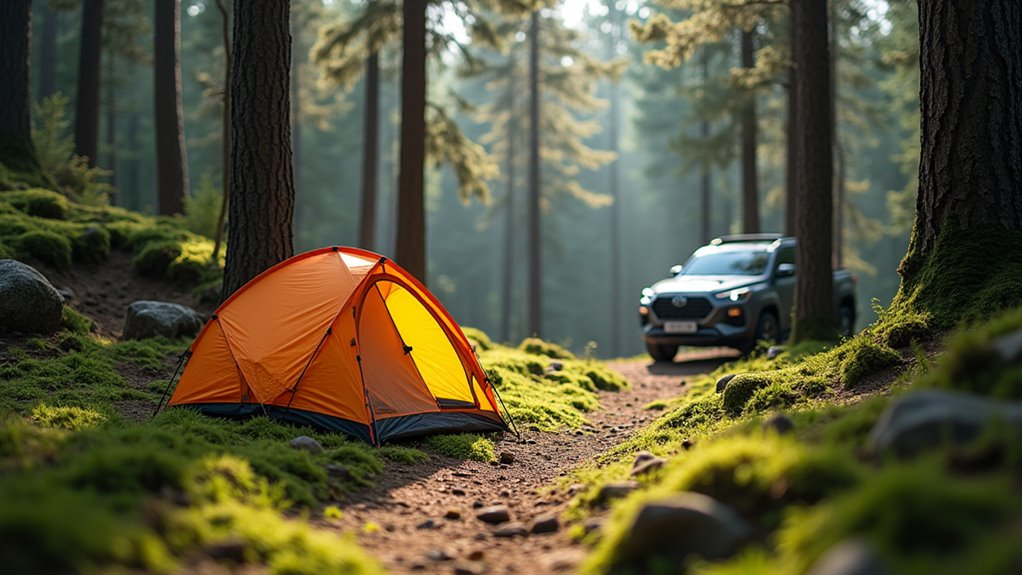Physical Address
304 North Cardinal St.
Dorchester Center, MA 02124
Physical Address
304 North Cardinal St.
Dorchester Center, MA 02124

A comprehensive guide to reducing your camping footprint through simple, budget-friendly choices that will transform your outdoor adventures forever.
You’re probably aware that camping can leave a hefty environmental footprint, but you don’t need to sacrifice your outdoor adventures or break the bank to camp responsibly. With a few strategic choices about where you go, what you bring, and how you behave in nature, you’ll dramatically reduce your impact while often saving money in the process. The key lies in understanding which specific actions make the biggest difference.

Before you pack your first piece of gear, you’ll want to map out a camping strategy that won’t break the bank or harm the environment. Start by choosing established campgrounds over pristine wilderness areas – they’re cheaper and reduce your ecological footprint.
Research local Leave No Trace guidelines and camping regulations beforehand to avoid fines.
Book campsites close to home to cut fuel costs and emissions. Look for campgrounds with recycling facilities and composting toilets. Check if they offer firewood on-site rather than transporting your own, which prevents spreading invasive species.
Create a meal plan using local, seasonal ingredients you can buy near your destination. Pack reusable containers instead of disposables.
Finally, coordinate carpooling with fellow campers to split gas costs while reducing your group’s environmental impact. Remember that following Leave No Trace principles means ensuring you don’t leave anything behind when you move on from your campsite.
Once you’ve planned your sustainable camping approach, you’ll need gear that matches your eco-friendly goals without emptying your wallet.
Start by prioritizing durable equipment that’ll last for years. Quality gear costs more upfront but saves money long-term while reducing waste. Look for items made from recycled materials or sustainable sources like bamboo cookware and organic cotton sleeping bags.
Invest in durable, sustainable gear made from recycled materials—it costs more initially but saves money while protecting the environment.
Consider these budget-friendly eco-swaps:
You don’t need to replace everything at once. Gradually upgrade your gear as items wear out, choosing sustainable alternatives each time.
Borrow or rent specialized equipment you’ll rarely use, and shop secondhand outdoor stores for quality gear at reduced prices. For water-based camping adventures, consider the financial benefits of renting boats rather than purchasing them outright for occasional use.

After selecting your eco-friendly gear, your choice of campsite and how you get there can make or break your environmental impact goals. Look for established campsites with existing fire rings, cleared areas, and designated paths. These spots prevent you from damaging pristine environments while providing necessary facilities.
Skip remote, untouched locations that require creating new trails or clearings. Instead, choose sites within 200 feet of water sources but not directly adjacent to them.
For transportation, carpool with fellow campers to reduce fuel consumption and costs. If driving solo, plan efficient routes and combine errands before leaving town. Consider camping closer to home – you’ll save gas money and discover hidden gems in your region. Public transportation to trailheads works too when available.
Late summer offers ideal conditions for eco-friendly camping with cooler temperatures and fewer crowds at popular camping destinations.
Your campsite selection sets the foundation, but how you actually set up camp determines whether you’ll leave the area better or worse than you found it. Smart setup protects fragile ecosystems while keeping your gear budget intact.
Follow these essential principles:
Proper tent setup also prevents moisture buildup that can damage both your gear and the ground beneath, especially during cold weather camping when condensation becomes a major concern.
You’ll preserve wilderness integrity without spending extra money on specialized equipment.

While setting up responsibly forms the foundation of ethical camping, practicing Leave No Trace principles throughout your entire wilderness experience guarantees you’ll safeguard these natural spaces for future adventurers.
Pack out everything you brought in—including food scraps and biodegradable soap. You’d be surprised how orange peels and banana skins harm local ecosystems. Dispose of waste water 200 feet from water sources, and scatter strained dishwater to help soil absorption.
Stay on established trails to prevent erosion and vegetation damage. When nature calls, dig catholes 6-8 inches deep and 200 feet from water, trails, and campsites.
Resist taking “souvenirs” like rocks, antlers, or flowers. Leave natural objects where you found them. Keep campfires small and use existing fire rings when available. These simple practices cost nothing but preserve wilderness integrity.
Beyond environmental stewardship, eco-friendly camping creates the perfect opportunity for family adventure that brings everyone together in nature’s classroom.
Since water is often your heaviest and most precious camping resource, smart conservation strategies will lighten your pack while protecting the environment. You’ll save money and reduce your ecological footprint with these efficient practices.
For effective waste and water management:
You’ll also want to pack out all trash, including organic waste like fruit peels that don’t decompose quickly in wilderness environments. These simple steps protect water quality while keeping your gear minimal.

Although wildlife encounters create memorable camping experiences, preserving proper distance and respecting natural habitats guarantees both your safety and the animals’ wellbeing. You’ll want to observe animals from at least 25 yards away—100 yards for bears and wolves. Never feed wildlife, as this creates dangerous dependencies and aggressive behavior.
Store food in bear-proof containers or hang it properly to prevent attracting animals to your campsite. Keep your campsite clean and pack out all food scraps, even tiny crumbs.
Stay on designated trails to avoid trampling vegetation and disturbing nesting areas. Don’t collect rocks, plants, or natural souvenirs—leave everything as you found it. Use existing fire rings rather than creating new ones, and choose durable surfaces for activities.
When planning your camping trip, research the specific Leave No Trace principles for your destination to ensure you’re following all local regulations and environmental guidelines.
These simple practices protect ecosystems while keeping camping affordable and accessible for future generations.
You’ve mastered the methods for mindful, money-saving camping that protects precious places. By choosing cheap, chartered campsites, selecting second-hand supplies, and practicing proper principles, you’re preserving nature’s beauty while building brilliant budget-friendly adventures. Remember to respect wildlife, reduce waste, and follow fundamental Leave No Trace guidelines. Your commitment to conservation creates cleaner campsites for countless future campers. Pack purposefully, camp consciously, and you’ll discover that sustainable adventures aren’t just environmentally excellent—they’re economically smart too.